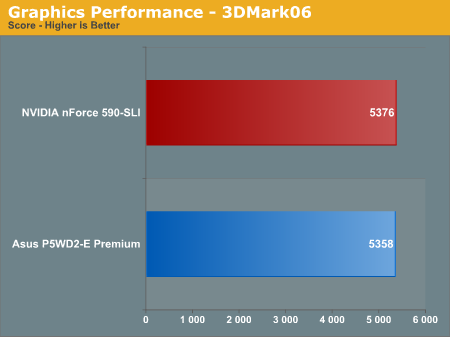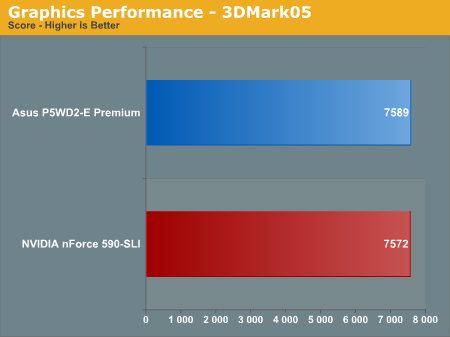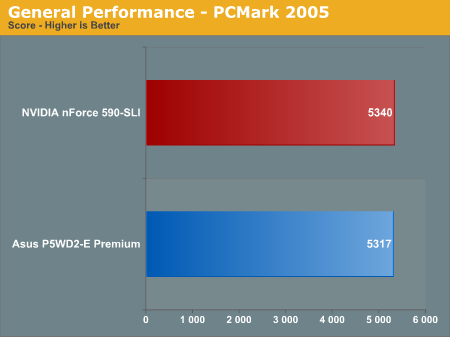nForce 590 SLI Intel Edition: NVIDIA prepares an Intel 975X Killer
by Gary Key on June 27, 2006 6:15 AM EST- Posted in
- CPUs
Synthetic Graphics Performance
The 3DMark series of benchmarks developed and provided by Futuremark are among the most widely used tools for benchmark reporting and comparisons. Although the benchmarks are very useful for providing apple to apple comparisons across a broad array of GPU and CPU configurations they are not a substitute for actual application and gaming benchmarks. In this sense we consider the 3DMark benchmarks to be purely synthetic in nature but still valuable for providing consistent measurements of performance.



In our first tests, each platform score is so close that there is no winner here - or for the non-pessimists, both boards are winners. In the memory and CPU sensitive 3DMark01 benchmark we see the NVIDIA board has a very slight edge. Although we have not reported memory benchmark scores in this article, the NVIDIA board did perform slightly better than the i975X board at stock settings. This slight advantage will show up in our other memory sensitive benchmarks.
General System Performance
The PCMark05 benchmark developed and provided by Futuremark was designed for determining overall system performance for the typical home computing user. This tool provides both system and component level benchmarking results utilizing subsets of real world applications or programs. This benchmark is useful for providing comparative results across a broad array of Graphics subsystems, CPU, Hard Disk, and Memory configurations along with multithreading results. In this sense we consider the PCMark benchmark to be both synthetic and real world in nature while providing consistency in our benchmark results.

The margins are extremely close in the PCMark05 results but the NVIDIA platform continues to show an advantage over the Intel platform even though it is very slight. While looking at the individual test results, we noticed the NVIDIA board had significantly better hard disk and graphics based scores while the i975X board had better multitasking results.
The 3DMark series of benchmarks developed and provided by Futuremark are among the most widely used tools for benchmark reporting and comparisons. Although the benchmarks are very useful for providing apple to apple comparisons across a broad array of GPU and CPU configurations they are not a substitute for actual application and gaming benchmarks. In this sense we consider the 3DMark benchmarks to be purely synthetic in nature but still valuable for providing consistent measurements of performance.



In our first tests, each platform score is so close that there is no winner here - or for the non-pessimists, both boards are winners. In the memory and CPU sensitive 3DMark01 benchmark we see the NVIDIA board has a very slight edge. Although we have not reported memory benchmark scores in this article, the NVIDIA board did perform slightly better than the i975X board at stock settings. This slight advantage will show up in our other memory sensitive benchmarks.
General System Performance
The PCMark05 benchmark developed and provided by Futuremark was designed for determining overall system performance for the typical home computing user. This tool provides both system and component level benchmarking results utilizing subsets of real world applications or programs. This benchmark is useful for providing comparative results across a broad array of Graphics subsystems, CPU, Hard Disk, and Memory configurations along with multithreading results. In this sense we consider the PCMark benchmark to be both synthetic and real world in nature while providing consistency in our benchmark results.

The margins are extremely close in the PCMark05 results but the NVIDIA platform continues to show an advantage over the Intel platform even though it is very slight. While looking at the individual test results, we noticed the NVIDIA board had significantly better hard disk and graphics based scores while the i975X board had better multitasking results.










37 Comments
View All Comments
rallyhard - Friday, June 30, 2006 - link
I, too, would like to see some RAID benchmarks for the motherboards when they're reviewed. Maybe even just reviewing the performance of a particular HD/RAID controller once, when it is tested on the first motherboard that you come across with that controller, would suffice.(I don't know how much HD/RAID performance varies from mobo to mobo with the same controller)
I certainly wouldn't have bought my Gigabyte 7n400 Pro2 socket A board if I had known the performance penalty of running RAID on the ITE 8212 chip as opposed to running a single drive on the nForce2 controller. The IDE raid functionality was the only reason I chose that board over the Abit NF7. The only way I found out that my horrible performance was truly and solely due to that 8212 chip is by doing a search on that chip and reading forums.
Incredibly, some manufacturers are still using that same chip for their IDE.
Anyway, I'm sure IDE performace is now a moot point for most, but yeah, RAID performance testing on future mobo (or controller) testing would, to me, be a useful addition to your excellent reviews.
Keep up the good work!
Crassus - Tuesday, June 27, 2006 - link
Perhaps someone can enlighten me on this: How much of an real-world impact in contemporary games does SLI 8/8 lanes compared to 16/16 lanes have? I remember reading an article about this issue back in the days when PCI-E was introduced, but I haven't really heared anything about it since. So, did anyone do a test on this?DigitalFreak - Tuesday, June 27, 2006 - link
I think X-Bit did a test not so long ago, and concluded there is still no advantage of 16x16 over 8x8.Avalon - Tuesday, June 27, 2006 - link
Sheesh, this is a pre-production board.CrystalBay - Tuesday, June 27, 2006 - link
Sheesh, look at the size NB fan.nullpointerus - Tuesday, June 27, 2006 - link
Just below the big features table on the basic features page, there's a sentence which should read:"Intel didn't officially want their 975X chipset to support 533FSB processors, but [a few] motherboard manufacturers disagreed on this point[, and] the end result is that 975X motherboards are able to run Celeron D chips."
At least I think that's how it's supposed to read.
nullpointerus - Tuesday, June 27, 2006 - link
Further down:"Considering the layout of expansion slots on ATX/BTX motherboards, [this] would be our ideal configuration, and the remaining expansion slots can be filled out with either X1/X2 PCI-E or regular PCI connectors."
...and also:
"There really doesn't see[m to be] much point in including X1 physical slots, particularly on enthusiast level hardware, and ATI at least has already recommended that motherboard manufacturers begin including more X16 physical connectors."
Gary Key - Tuesday, June 27, 2006 - link
Jarred and I got our wires crossed during the edit process this morning, it was easy to do at 5:30am after being up for about 26 hours with this board and another "new" chipset preview that should be finished shortly. ;-> However, no excuse on my part for not noticing the missing/incorrect text. I have corrected our mistakes and sincerely hope the changes are acceptable. Thank you for the comments and taking time to write. :)PedroDaGr8 - Tuesday, June 27, 2006 - link
I noticed on the compression/decompression page, page 7 I think. Both of the graphs are labeled File compresision - WinRAR 3.60b5 602MB Test Folder - Time In Minutes - Lower Is Better. Shouldn't one of them (the bottom one I guess) be labeled File Decompression, or atleast since you mention it first in the article shouldn't it be on top. That led to a quick bout of confusion for me, hey maybe it is just the painpills (I blew out my knee last week, tore my ACL and LCL (Lateral Colateral Ligament) with possible damage to my PCL and MCL as well. Nothing like playing cricket for the first time and injuring yourself.JarredWalton - Tuesday, June 27, 2006 - link
I added a word to the subtitle now. Basically, File Compression is the benchmark category, followed by the benchmark application. The subtitle is for extra information about the particular test. Hopefully that makes sense - I can't say my brain is entirely functional at this hour of the morning. :)